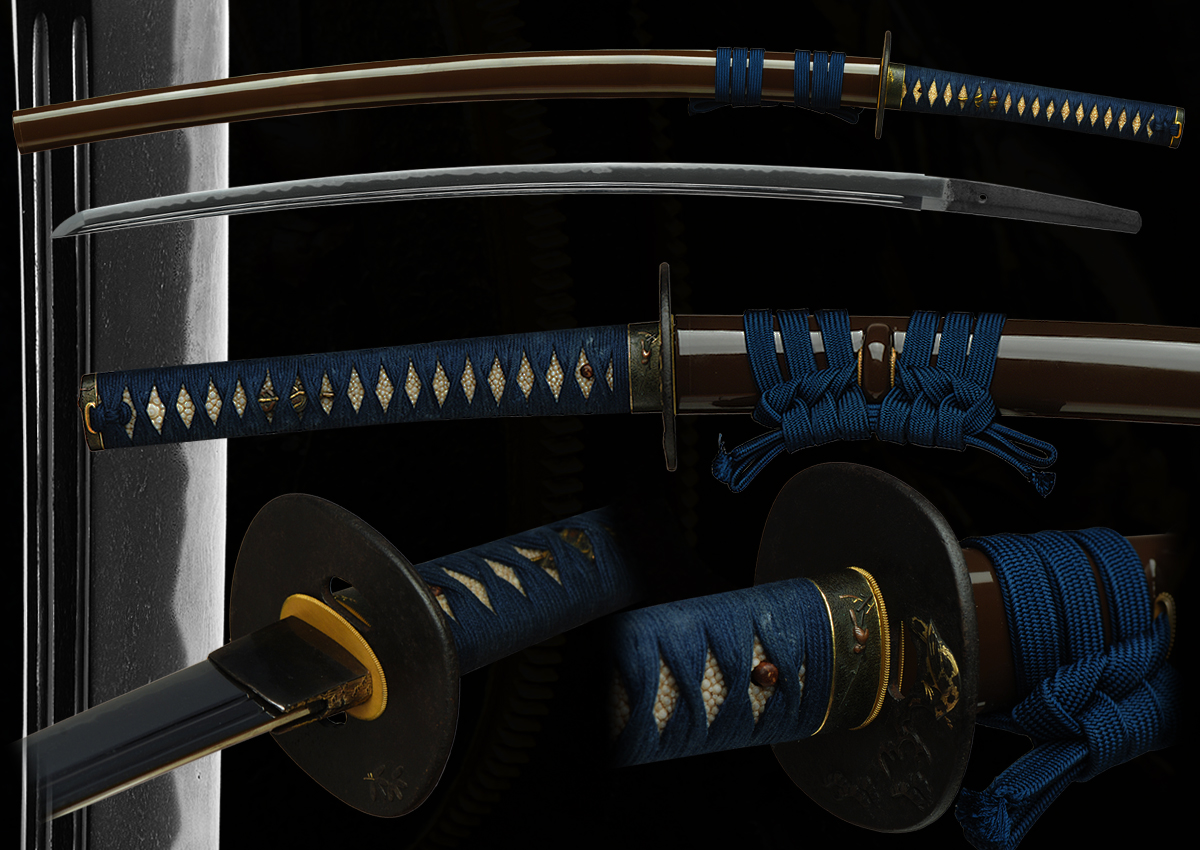This beautifully shaped katana comes in a very nice older polish. The hamon is an erratic blend of chogi-midare with much togare-ba. The blade was made in the 1600’s. The hada is in a ko-itame style. This katana shows off the swords fine uniqueness and we would say that this was a true samurai blade and not just for show. The blade is in a good polish and is papered as. This sword has double bohi and some slightly course areas due to its age.
The koshirae is of a quality lacquered saya in a deep high gloss rich brown lacquer . This package is a standout. The tsuka has a brilliant deeper blue tsuka-ito with matching sageo. The menuki are a fine quality gold with shakudo of ancient samurai implements. The fuchi kashira are a fine quality shakudo with bird relief design. There is a fine quality iron tsuba with beautiful hawk and there is double narrow bohi on both sides of the blade.
- Mei: Mumei
- Date: Edo (1600’s-1700’s)
- Nagasa: 27-1/2 inches
- Sori: 24.0 mm
- Width at the ha-machi: 29.5 mm
- Width at the yokote: 19.6 mm
- Thickness at the mune-machi: 7.1 mm
- Construction: Shinogi zukuri
- Mune: Iori
- Nakago: Ubu
- Kitae: ko-Itame
- Hamon: Midare choji
- Boshi: Maru
- Condition: Good polish
Email us if your interested in this item and remember to include the order number for this item: fss-633.
kantei-sho (鑑定書) – Certificate Den Kishû Ishidô (伝紀州石堂)
shôshin (正真) – Authentic
nagasa 2 shaku 3 sun 1 bu kore ari (長さ貮尺参寸壱分有之) – Blade length ~ 70.0 cm
Heisei 25 nen 8 gatsu 4 nichi (平成二十五年八月四日) – August 4th 2013 Nihon Tôken Hozon Kai (日本刀剣保存会) – NTHK
No 17,889
meibun (銘文) – Signature: mumei
kitae (鍛) – Foging: ko-itame
hamon (刃紋) – Hardening:ko-chôji-midarebôshi (鋩子) –
Hardening in tip: sugu with a ko-maru-kaeri
chôkoku (彫刻) – Engravings: futasuji-hi
nakago (中心) – Tang:mekugi-ana (目釘穴) 1, yasurime (鑢): kiri
bikô (備考) – Remarks:around Enpô (延宝, 1673-1681)
shinsa’in natsu’in (審査員捺印) – Seals of Judges: 4 seals
The Kishû-Ishidô School
To origins of the Ishidô School are located in Ômi province. There exist several theories on the actual ancestor but apart from that, it is safe to assume that the scholastic origins are to be found within Muromachi-period Bizen smiths who had immigrated to Ômi and who were settling in the vicinity of the Ishidô temple, what earned the school its name. With entering the Edo period, the school split up into several branches whereas the initial, the Ômi-based school is referred to as Ômi-Ishidô. One branch goes back to smiths who moved right away from Ômi to Edo. This branch is referred to as Edo-Ishidô. Another one, the Fukuoka-Ishidô branch, goes back to smiths who studied with the Edo-Ishidô School but who worked for the Fukuoka fief of Chikuzen province. Then there was a group of smiths that moved from Ômi down to Kii province which is referred toas Kishû-Ishidô accordingly. From Kii, one lineage moved to Kyôto and is thus referred to as Kyô-Ishidô whereas the majority of the successors of the smiths who onced moved from Ômi to Kii decided later to relocate the school to the then thriving trade centre of Ôsaka. The branch that flourished after the move to Ôsaka is referred to as Ôsaka-Ishidô.
As for the classification Kishû-Ishidô, it refers in a stricter sense to smiths who mainly worked in Kii, i.e. for the so-to-speak “stopover” smiths from Ômi to Ôsaka. These were Tosa no Shôgen Tameyasu (土佐将監為康), his son Mutsu no Kami Tameyasu (陸奥守為康), and the two generations Yasuhiro (康広), which must not be mixed-up with their more famous namesake Bitchû no Kami Yasuhiro (備中守 康広) who moved later to Ôsaka. But the classification can also be seen in a wider sense, namely also referring to the group of smiths that relocated to Ôsaka and to their direct students. Thus the classification Kishû-Ishidô can encompass, in the stricter sense, works from Keichô (慶長, 1596-1615) and Kan ́ei (寛永, 1624-1644) that were made in Kii province and, in the wider sense, blades that were even made up to Kanbun (寛文, 1661-1673) and Enpô (延宝, 1673-1681) and in Ôsaka.
For Sale

























